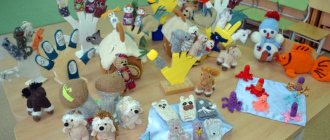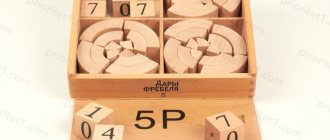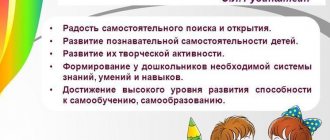Innovative technology in preschool education “Club Hour”
Innovative technologies in preschool institutions play a huge role in the development of children. And the more interesting the technology, the more effective the result. In my article I want to talk about the effectiveness of such innovative technology as “Club Hour”, and about experimental activities that were tested in our preschool institution. For this activity, I wrote a project that was implemented both during Club Hour and in my free time.
Childhood is a promise that never comes true.
Ken Hill
“There are now many problems with the intellectual development of modern preschool children. But the development of children begins in childhood. What do we know about childhood? “Due to the widespread prevalence of this concept, each of us is sure that we know everything about childhood and can easily explain this phenomenon and its significance in the life of an adult. But it is precisely this simple understanding of childhood from a philistine point of view that hides the unidentifiability and inexplicability of this phenomenon. As J. Korczak rightly writes: “We don’t know children, worse, we know them through prejudice.” [1, p.16]
Therefore, in preschool organizations, teachers began to use various modern innovative technologies to ensure that the level of children’s preparation for school was high. The leading activity in preschool educational institutions is play. “A game is an activity used for entertainment, recreation, or sports competition.” [2]. One of the gaming technologies is Club Hour.
“Club hour” is a pedagogical technology aimed at developing self-regulation (voluntariness) of behavior, the ability to plan activities, and evaluate results. It is impossible to implement pedagogical technology without a clear definition of tasks.
One of the main tasks of education that any teacher sets for himself is the socialization of students. It is in kindergarten that children learn to make friends, play, communicate, and begin to feel like members of a large children's team. The foundations of patriotic feelings are formed in children.
“Club hour, a technology that allows children, under the invisible control of adults, to move freely around the territory of a kindergarten or school and in different rooms to choose the activities that they like. Acquire your own life experience and experiences, which are so necessary for self-determination and self-regulation of behavior.” .
Through the Club Hour there is live communication with other teachers and children.
The main goals of the CC:
– instilling in children independence and responsibility for their actions;
– developing the ability to plan your actions and evaluate their results;
– acquisition of one’s own life experience (semantic formations) experiences necessary for self-determination and self-regulation.
– training in spatial orientation;
– nurturing friendly relations between children of different ages, respectful attitude towards others;
– development of children’s desires to express their attitude towards the environment, to independently find various speech means for this;
– strengthening children’s skills to politely express their request and thank them for the service provided;
– teaching children how to resolve controversial issues and resolve conflicts;
– promoting the manifestation of initiative in caring for others, being grateful to help and signs of attention;
– encouraging the child’s attempts to consciously share various impressions with the teacher and other children.
According to Grishaeva, Club hours are divided into types:
- Activity - this type is based on the child’s self-determination in choosing various types of activities;
- Thematic - in this case, “Club hours are included in the situation of the month”;
- Free - children move freely around the territory of the kindergarten and independently organize communication of different ages based on interests without the help of adults;
- Creative - children of the preparatory group themselves organize all the activities at the “Club Hour” for all children;
- Group formation - children spend “Club Hour”, uniting in groups and teams to develop group skills;
- Quest - children on the territory of a site or premises, alone or in a team, look for some thing or object according to a scheme, solve some problem;
- Museum - children in the “situation of the month” collect exhibits, and then at the end of the month, independently conduct excursions for other children who came. [3]
I developed the project “Experiments - Focuses - Experiments”. It was included in the general innovation project of our preschool institution “Cognition through experience, experience through cognition.” The goal of the overall project was to create conditions to support exploratory behavior in preschoolers in kindergarten. This project included four subprojects: “Laboratory”, “Magic Sand”, “The Charming World of the Microscope” and my “Experiments - Tricks - Experiments”.
The goal of my project was to create conditions for experimental activities of children in kindergarten, the formation of an environmental culture, and the development of cognitive interest. Having worked for many years in a preschool institution, I have observed many times how children like something unusual and wonderful. Therefore, the relevance of my project was indicated by the fact that research provides an opportunity for a child to answer the questions “how?” and why?". An unquenchable thirst for new experiences, curiosity, a constant desire to experiment, and independently seek new information about the world are considered the most important features of children's behavior. Research activity is the natural state of a child; he is determined to understand the world, he wants to know everything and be able to do everything himself. This is a huge opportunity for children to think, reflect, try, experiment, and express themselves. The experiments somewhat remind children of magic tricks, they are unusual, they surprise. The child’s need for new impressions underlies the emergence and development of inexhaustible orientation-research (search) activity aimed at understanding the world around him. The more varied and intense the search activity, the more new information the child receives, the faster and more fully he develops.
My project objectives:
– create conditions for the formation of cognitive interest in children.
– develop children’s curiosity in the process of observation and practical experimentation with objects.
– to form skills of mental actions, analysis in the process of cognition of the natural picture of the world, contributing to the development of speech.
– develop independence in resolving problem situations in research activities.
– learn to explain what is observed.
The topics planned for the Club Hour were also planned for my project. The children and I mixed paints, got new colors, studied the properties of water, magnets, iron, and fabric. We conducted experiments with light and a mirror. A card index of experiments was developed, with explanations. Tables for conducting experiments were developed and drawn. At the Club Hour, children watched an experiment conducted by a teacher. Then there was a discussion, and at the end the children could independently conduct the experiment and draw it themselves. I and the parents were given advice on “Organizing children’s experimentation at home.” In a preschool educational institution, on experimental activities, I conducted a master class for teachers “Experiments with children.” The purpose of the master class was to improve the professional skills of participating teachers in the process of active pedagogical communication on the problem of children's experimentation.
As a result, at the end of the school year, the children could independently, based on the diagrams, conduct experiments and explain them.
Literature:
- Gogoberidze, A. G. Preschool pedagogy with the basics of methods of education and training / A. G. Gogoberidze, O. V. Solntseva. — 2nd edition, revised and expanded. - St. Petersburg: Peter, 2015. - 460 p. — Text: direct.
- Ozhegov, S. I. Ozhegov’s Explanatory Dictionary - online / S. I. Ozhegov. — Text: electronic //: [website]. — URL: (access date: 01/24/2021).
- Shchetinina, M. V. “Club Hour” technology as a form of support for children’s initiative” / M. V. Shchetinina. — Text: electronic // Doshkolenok.rf: [website]. — URL: https://doshkolnik.ru/pedagogika/27367-tehnologiya-klubnyiy-chas-kak-forma-podderzhki-detskoiy-iniciativy.html (access date: 01/24/2021).
CHILDHOOD GUIDE
From work experience
"Club hour as an effective technology
positive socialization of preschool children"
Churkina Anna Innokentievna,
teacher of preschool educational institution No. 14,
Cheremkhovo, Irkutsk region.
One of the most important tasks of the preschool period is the socialization of the child and its most important part is the development of sociability , that is, the ability to communicate with peers and adults.
The need for communication is one of the most important human needs. Relationships with other people begin and develop intensively in childhood. Without full communication, a child will not be able to socially adapt in society , and this will also affect intellectual development and the formation of personality as a whole.
This problem is of particular importance at the present time, when the moral and communicative development of children is of serious concern. It's no secret that the best friend for a modern child is a TV or a computer, and his favorite pastime is watching cartoons or computer games. Children began to communicate less not only with adults, but also with each other. But live human communication significantly enriches the lives of children and paints the sphere of their sensations with bright colors.
Communication with peers occupies an important place in a child’s life: the pace of development of the child, his sense of self and self-esteem, and attitude towards other people depend on how successfully it develops. In communicating with peers, he learns to build relationships according to certain rules. Recognize yourself as a subject in a system of social relations.
Thus, the formation of the communicative competence of a preschool child is an urgent problem of modern preschool pedagogy.
a new technology as “Club Hour” in our kindergarten
“Club hour” is a special modern technology for developing a child’s personality. The pedagogical technology is that children can freely communicate with each other for one hour and move around the kindergarten, observing certain rules of behavior, and return to the group when the bell rings.
The main goals of the “Club Hour” are:
- fostering friendly relations between children of different ages,
respectful attitude towards others;
- instilling in children independence and responsibility for their actions;
- spatial orientation training;
- developing the ability to plan your actions and evaluate their results;
- strengthening children’s skills to politely express their request and thank them for the service provided;
- the development of children’s desires to express their attitude towards the environment, to independently find various speech means for this;
- teaching children how to resolve controversial issues and resolve conflicts;
- encouraging the child’s attempts to consciously share various impressions with the teacher and other children;
- acquiring one's own life experience (meaning formations) experiences necessary for self-determination and self-regulation.
The following types of “Club Hour” can be distinguished
- free. Children move freely throughout the entire territory of the kindergarten (indoors or outdoors) and independently organize communication of different ages based on interests without the help of adults;
- thematic. In this case, "Club hours" are included in the situation of the month.
- active. This type of “Club Hour” is based on the child’s self-determination in choosing various types of activities.
- creative. Children of the pre-school group themselves organize all the activities at the “Club Hour” for all children.
To conduct a club hour, educators and specialists first discuss and determine:
1) The theme of “Club Hours” - a long-term thematic plan for the six months. This is necessary, since “Club Hour” can be carried out in various forms: as an educational activity in the morning, as an activity in interest groups in the evening, as one of the forms of organizing a walk or leisure time.
2) Frequency and duration of the “Club Hour”. Activities typically take place once a week at the beginning of the program and 2-3 times a week thereafter. One of the main conditions for holding a “Club Hour” is its duration, namely at least 1 hour, since otherwise children do not have time to gain their own life experience;
3) Rules of conduct for children during Club Hour:
- “Say “hello” and “goodbye” when you enter another group”;
- “If you took a toy to play, put it back when you leave”;
- “Do not take toys from other children if they took it first”;
— “Help conduct the lesson if it takes place during the “Club Hour”;
- “Speak calmly”;
- “Walk calmly”;
- “Return to the group when the bell rings”;
— “If you don’t want to go to other groups, then you can stay in your group or return to it if you’re tired”;
4) organizational aspects of the “Club Hour”. All kindergarten employees are warned about the day and time of the event. The event goes like this. The entrance doors to the garden are closed. Employees are at their workplaces and go about their daily business, waiting for the children to arrive. If possible, they communicate with guests, show and talk about their activities. Children are also encouraged to help employees with their work. To achieve this, various activities are prepared in advance for visiting children. At the end of the “Club Hour”, the person in charge passes through all floors (groups), for example, with a bell, giving a signal that it is time to return to the groups;
5) organizational aspects of the “Club Hour”. The preschool team determines how many groups and which ones will participate in the first event, how to prepare children for the first “Club Hour”.
Preliminary work is also carried out with children of the senior and preparatory groups:
1) a discussion is organized during which older preschoolers learn what “Club Hour” is and why it is needed, what they will do during this event and who would like to go to it;
2) it is discussed what groups there are in the kindergarten, the age of the children in these groups and on what floor (wing) they are located;
3) it explains what rooms there are in the kindergarten, what they are called, who works there, what they do and what benefits they bring;
4) a plan (map) is issued of what is happening and where, depending on what type of “Club Hour” is planned - thematic, activity-based or creative;
5) penalties are established for non-compliance with the rules. Immediately before the Club Hour, the children discuss all the rules. A plan map is kept, each child plans where he wants to go. Instructions are given: “Children, you can move around the entire building for one hour, observing the rules of behavior. And at the ringing of the bell you return to the group.”
6) after the end of the “Club Hour”, all children participating, each in their own group, with a teacher, sit in a circle on the carpet, a discussion begins - a reflective circle. The teacher makes sure that the children do not interrupt each other and patiently wait for their turn to speak.
The following questions are discussed:
-Where was the child?
- What do you remember?
— Do you want to go there again and why?
— Did you plan to go somewhere before Club Hour? Were you able to accomplish this and if not, why?
— Did you manage to follow the rules, if not, then why. The teacher records the problems that children have during the “Club Hour” and discusses them with children and parents (at a suitable time), finding ways to solve them in joint activities.
7) after each event at the pedagogical council, educators, teachers and employees exchange opinions on:
- what the children did when they came to his territory, what was special in the children’s behavior;
- how did the children who remained in their group react when guests came to them (a question for teachers);
— did the children follow the rules, and what prevented them from complying with them, were there any conflicts;
— what tasks need to be solved at the next “Club Hour”.
As noted, during the event children can move freely throughout the entire kindergarten building (“go wherever you want, do whatever you want”). At the same time, at the initial stage of the “Club Hour” for children, it is advisable to organize a wide variety of activities: an art studio, a music club, make free entry to the gym, to the accounting department, to the nurse, to the kitchen, and not only to watch, but also to do something interesting. And for safety, nannies can constantly “clean” the stairs and corridors, without interfering with the children’s movements, without making comments, but quietly keeping an eye on them. For the first time , children find themselves not as guests, but as owners of the kindergarten. As if from a locked cage, they escape from the group room. Having escaped from constant guardianship, children very quickly acquire the ability to independently find something to do and bring it to the end. They easily learn what an hour is... and plan how best to spend it.
“Club Hour” proved that five- and six-year-olds are not only able to take advantage of the freedom provided, but are also able to draw certain conclusions.
Literature:
Mikhailova-Svirskaya L.V. Individualization of education for preschool children. A manual for preschool teachers. (We work according to the Federal State Educational Standard for preschool education) - M.: Prosveshchenie, 2015.
Mikhailova-Svirskaya L.V. Children's council: methodological recommendations for teachers. – M.: publishing house “National Education”, 2015.
Modern technologies for effective socialization of a child in a preschool educational organization.
Federal State Educational Standard. /Author of the article Researcher, IS RAS Grishaeva Natalya Petrovna//Editor Sukhova E.A.: Ventana-Graf Publishing House, 2015. https://www.labirint.ru/books/463129 Forms of organizing positive socialization of preschool children Application of pedagogical technology “Game technology” in preschool education Features of socialization and the formation of communicative relationships in children with a complex structure of the defect Psychological support for preschool children in the process of developing communicative competence >
Club hour as a means of developing children's initiative
Organizers:
Federal State Autonomous Institution “Federal Institute for Educational Development” (FSAU “FIRO”), Publishing House “Linka-Press” and the editors of the magazine “Obruch”.
Authors: Grishaeva Natalya Petrovna, Art. Researcher at the Institute of Sciences of the Russian Academy of Sciences, scientific director of an innovative platform for the effective socialization of preschool children.
Strukova Lyubov Mikhailovna, educational psychologist of the ANOO "Gymnasium of St. Basil the Great", responsible organizer of innovative socialization platforms.
Form of participation: correspondence (webinar)
Date: April 12, 2022
View webinar recording
Deadline for submitting materials for publication in an electronic collection (for those interested):
until April 20, 2022.
The webinar is addressed to specialists in the field of preschool education, practicing teachers, senior educators, methodologists, psychologists, speech therapists, and heads of structural units.
Thematic plan:
- Current problems solved by the “Club Hour” technology:
- — implementation of the Federal State Educational Standard;
- — increasing kindergarten attendance, including on Fridays;
- — assistance in teaching children;
- — development of personal qualities;
- - reduction of parental complaints;
- — increasing teachers’ interest in their work;
- — rallying a team of like-minded people;
- — increasing the prestige of the kindergarten in the district.
2. Technology for holding the “Club Hour”:
- preparation of territory for CP;
- informing parents;
- informing children;
- development of CC rules with children;
- teacher training.
3. Technology for conducting the “Reflective Circle” before and after the CC.
4. Types of “Club hours” (activity, thematic, free, creative, big game, quest, museum).
5. Technology for holding a “Club Hour” type “big game”
6. Preparing the team for the implementation of new technology.
7. Developmental communication technology.
The webinar is free. If you wish, you can purchase an electronic webinar participant certificate. The cost of preparing an electronic certificate is 300 rubles.
pay for the webinar participant certificate by receipt or online.
To order a certificate, please fill out the form:
Those interested can publish







